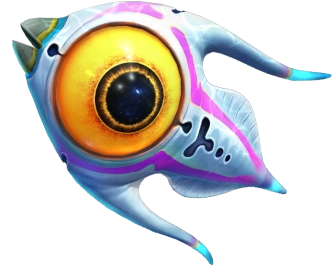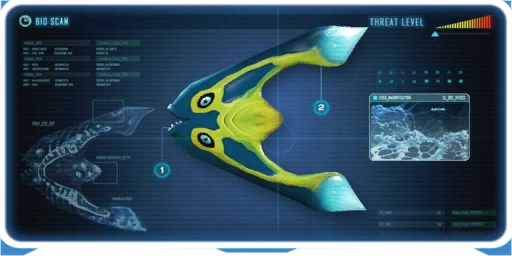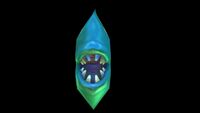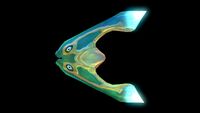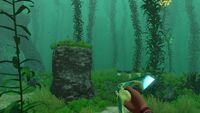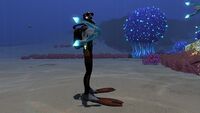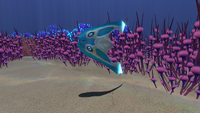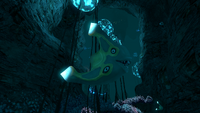The Boomerang is a small passive fauna species. It is extremely common and found in many Biomes.
The Boomerang is fairly easy to catch, especially during night time due to its diurnal behaviour, and has moderate Food values.
Appearance[]
The Boomerang is a small fish with a bright yellow-green center and dark green stripes along the sides and edges of its body. It is horizontally symmetrical, and, as its name suggests, similar in shape to a real life boomerang.
From the Boomerang's top and bottom protrude long, slim, pointed fins extending diagonally backwards from its main body. The tips of these fins give off a cyan bioluminescent glow. It has four eyes, two on each side of its head, being respectively above and below of its mouth. Although the Boomerang is a herbivore, it possesses a mouthful of sharp teeth, which are used for eating coral according to the PDA.
Behavior[]
The Boomerang sways side-to-side as it swims. If approached by the player, it will eventually flee.
It is a fast swimmer, and is usually found to be very active during the day. During the night, it usually finds shelter near the caves or the seabed.
They are commonly seen in Shoals around the map.
Uses in Crafting[]
Energy Value[]
Data Bank Entry[]
|
A herbivore encountered in large numbers, found to frequent shallow waters and move in schools. 1. Serrated Teeth: 2. Twin-fins: Most active during daylight hours, and prone to flee on approach, the boomerang can more easily be observed at night when its luminescence gives it away and it seeks the shelter of the seabed. Assessment: Edible |
Gallery[]
Trivia[]
- There is a subspecies of the Boomerang called the Magmarang, which resides in the Inactive Lava Zone.
- The Boomerang dwells in more places on the map than any other creature.
- The Boomerang is listed as a herbivore, but the data bank entry text describes it as adapted to feed on corals, making it a corallivore.
| Fauna living within the Crater | |
|---|---|
| Carnivores | |
| Herbivores | |
| Scavengers & Parasites | |
| Leviathans | |
| Extinct | |
| Other Entities | |
